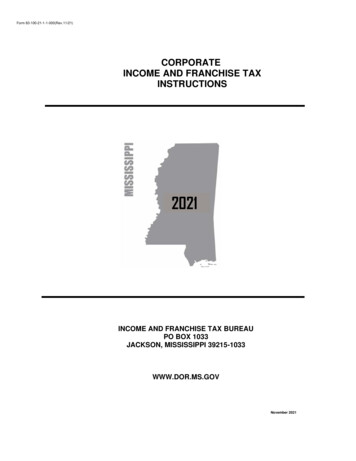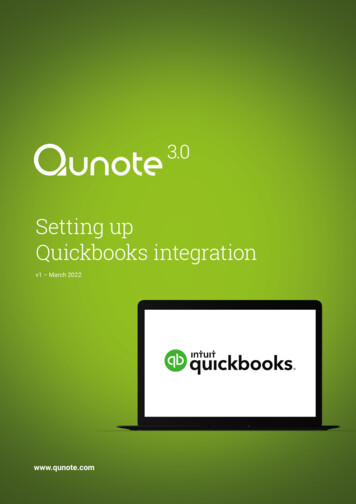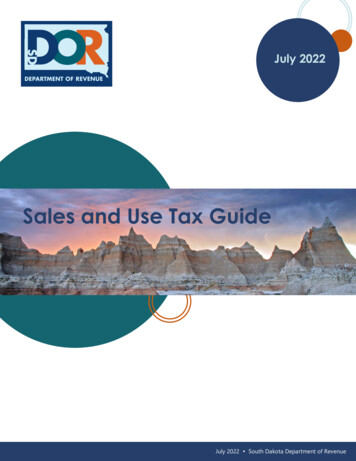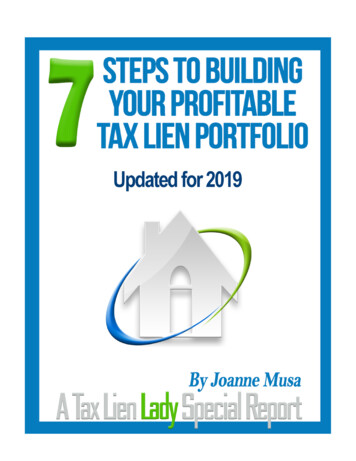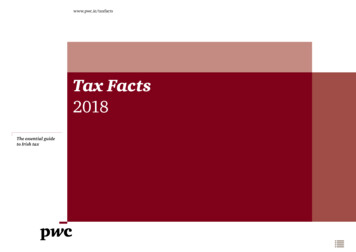
Transcription
www.pwc.ie/taxfactsTax Facts2018The essential guideto Irish tax
IndexTax Facts 2018 - IntroductionTax Facts 2018 - Editor’s page12Business taxation3Corporation tax3Corporation tax rates3Losses3Branch income3Asset management19Interest33Irish Real Estate Funds20Interest paid/payable33Global Information Reporting (FATCA & CRS)20Loans to finance corporate acquisitions / investment33Islamic Finance21Loans to acquire Interest in a Partnership33Deposit interest retention tax (DIRT)34DIRT & First Time Buyers34Corporate - withholding taxes (WHT)23Dividend WHT23Interest WHT23Local Property Tax35Royalties WHT23LPT Rates35WHT on capital gains23Returns36Professional services withholding tax (PSWT)24Late Payment/Non-Compliance36WHT rate reductions and exemptions24Income tax37Main personal tax credits and reliefs37Main tax allowances38Income tax exemption limits38Capital Gains3Company residence4R&D credit5Intellectual property tax deduction6Knowledge Development Box6Tax treaties25Tax depreciation8Multilateral Instrument25Leasing8Ireland as a holding company location9Value added tax (VAT)26Income tax rates38Closely held companies10General26Maternity Benefit39Start-up companies10Accounting for VAT26Alimony/maintenance payments39Corporate – Tax administration1026Personal Insolvency39Exempt activities27Remittance basis of taxation (RBT)3913Property27Domicile levy4013Section 56 Authorisation (formerly Section 13A)27Special assignment relief programme (SARP)4013Withdrawal of VAT credit for bills not paid within six months27Cross border workers4013Foreign earnings deduction (FED)41Advance Pricing Agreements14Stamp duty29Mutual Agreement Procedure (MAP)14Rates29Employment & Investment Incentive / Startup Refunds forEntrepreneurs (SURE)41Coffey Report Recommendations14Transfer/purchase of residential property29R&D tax credit41Transfer/purchase of other property29Relief for mortgage interest payments42Exemptions and reliefs30Rent relief for private accommodation42Rent a room scheme42Rental income43Help To Buy Incentive (HTB)43Transfer PricingOverviewTransfer Pricing Compliance ReviewCountry-by-Country ReportingRatesFinancial services16Banking and treasury16Insurance16Relevant contracts tax (RCT)31Aircraft leasing17Wide scope of RCT31Home Renovation Incentive (HRI)43Aviation Sector Capital allowances for aviation services17Operation of RCT31Living City Initiative43Section 110 companies17High Earner’s Restriction44Real Estate Investment Trusts (REIT)18Employment of a carer45Tax Facts 2018ii
IndexChildcare Services Relief45Pension schemes55Local taxes65Self assessment - payment and returns45Pension contribution rules – for employers55Environmental Taxes65Pension contribution rules – for individuals, the earnings limits55Customs and excise66Customs66Excise66Tax contacts68Appendix 170Withholding tax on payments from Ireland70Limited access rules for Additional Voluntary Contributions (AVCs) 58Withholding tax on payments from Ireland (continued)71Capital gains tax59Rates59Appendix 272Withholding tax on payments to Ireland72Losses60Withholding tax on payments to Ireland (continued)73Exemptions and reliefs60Impact of debt write-off62Self-assessment – payment and returns62Capital acquisitions tax63General63Calculation of CAT63Self-assessment – payment and returns63Main exemptions63Main reliefs64Discretionary trust64Employee taxation46Pension contribution rules – for individuals, the age related limits 55Termination payments46Pension accumulation rules – the lifetime pensions limitBenefits-in-kind (BIKs) - general46BIK on company cars46Pension distribution rules occupational pension schemes –the maximum pension allowed56BIK on preferential loans47BIK on professional subscriptions47Pension distribution rules – occupational pension schemes –the maximum lump sum allowed56BIK on travel passes and small benefits47Pension distribution rules – PRSA and personal pensions57Travel and subsistence47Motor travel rates48Subsistence rates - within Ireland48Travel and subsistence expenses for Non-ExecutiveDirectors (NEDs)48Employee share schemes49Unapproved employee share schemes49Revenue approved employee share schemes49Employer reporting requirements50Tax treatment of loans from employee benefit schemes50PRSI52Rates52Employee/Employer PRSI (Class A)52Self-employed PRSI (Class S)52PRSI classification of working directors53Universal Social Charge54The Universal Social Charge (USC)54Tax Facts 201855Pension distribution rules – Approved Retirement Funds (ARFs) 57Treatment of ARF Distributions for Double Taxation Agreements58iii
Tax Facts 2018 - The essential guide to Irish taxIndexIntroductionWelcomeBusiness taxationIntroductionTransfer PricingThis publication is a practical and easy-tofollow guide to the Irish tax system. Itprovides a summary of Irish tax rates as wellas an outline of the main areas of Irishtaxation. A list of PwC contacts is providedwithin each tax area and at the back of thisguide should you require more detailed adviceor assistance tailored to your specific needs.Financial ServicesCorporate - withholding taxes (WHT)Tax treatiesValue added tax (VAT)Stamp dutyRelevant contracts tax (RCT)InterestLocal Property TaxIncome taxJoe TynanTax and Legal Services LeaderEmployee taxationEmployee share schemesPRSIUniversal Social ChargePension schemesCapital gains taxCapital acquisitions taxLocal taxesCustoms and exciseTax contactsAppendix 1Withholding tax onpayments from IrelandAppendix 2Withholding tax onpayments to IrelandTax Facts 20181
Tax Facts 2018 – Editor’s pageIndexIntroductionWelcomeBusiness taxationTransfer PricingFinancial ServicesCorporate - withholding taxes (WHT)Tax treatiesValue added tax (VAT)Stamp dutyRelevant contracts tax (RCT)InterestLocal Property TaxIncome taxThis legislates for an administrative practiceoperated by Revenue with regard to companiesresident in these countries and brings CGT groupsinto line with loss groups.From a personal tax perspective, the principalchanges include a reduction in the UniversalSocial Charge (USC) rates and increases to thestandard rate tax band and certain tax credits.The Act also provides for the introduction of anew capital allowances regime to grantemployers capital allowance relief on the capitalcost of constructing and equipping qualifyingfitness or childcare facilities provided for use byemployees of the employer.A new share option incentive scheme, the KeyEmployee Engagement Programme (KEEP), hasbeen introduced. This scheme is aimed atensuring that unquoted SMEs can attract andretain key employees, allowing those employeesto avail of capital gains tax (CGT) treatment onshare options granted by the SMEs.The rate of stamp duty applicable to the transferof non-residential property and to shares derivingtheir value from Irish non-residential propertyhas increased to 6%, subject to certain limitedtransitional measures.Employee taxationEmployee share schemesPRSIThe Finance Act also provides for the introductionof a new tax on sugar-sweetened drinks which isexpected to come into operation in April 2018.Universal Social ChargePension schemesCapital gains taxFrom a corporate tax perspective, amendmentswere made to the intellectual property (IP)regime to provide for the reintroduction of the80% income cap for IP capital allowances. Thecap applies to IP purchased on or after 11October 2017.Capital acquisitions taxLocal taxesCustoms and exciseTax contactsAppendix 1Withholding tax onpayments from IrelandAppendix 2Withholding tax onpayments to IrelandTax Facts 2018Welcome to the latest edition of Tax Facts whichhas been updated for amendments brought aboutby Finance Act 2017 which was signed into lawon 25 December 2017.The scope of the Capital Gains Tax group reliefprovisions have been extended to includecompanies resident in countries with whichIreland has concluded a double tax agreement.For more informationcontact:Coffey Report RecommendationsThe Department of Finance commissioned anindependent report on Ireland’s corporate taxsystem in 2016. The report, known as the Coffeyreport, was released in September 2017. It is setagainst the backdrop of a number of EU directivesand agreements reached with a view tocoordinating implementation of the OECD’s BaseErosion and Profit Shifting (BEPS)recommendations.Fiona CarneySenior Managert: 353 (0)1 792 6095e: fiona.carney@ie.pwc.comThe report makes three key recommendationsaround modernising Ireland’s transfer pricingregime, recalibrating its existing IP regime andintroducing a competitive territorial regime.One recommendation which was adopted withimmediate effect in Finance Act 2017 is thereintroduction of the 80% cap for new spend onIP as outlined above.The Department of Finance is currently engagedin proactive consultation with business on theother recommendations to determine whatchanges should be made.Fiona CarneySenior ManagerTax Solutions Centre2
Business taxationIndexIntroductionWelcomeBusiness taxationCorporation taxTrading LossesTransfer PricingCorporation tax is charged on the worldwideprofits of companies that are tax resident inIreland and certain profits of the Irishbranches of non-resident companies. ‘Profits’for this purpose consist of income (business ortrading income comprising active income andinvestment income comprising passiveincome) as well as certain capital gains.A trading loss incurred in an accountingperiod may be offset against any of thefollowing:Financial ServicesCorporate - withholding taxes (WHT)Tax treatiesValue added tax (VAT)Stamp dutyRelevant contracts tax (RCT)Corporation tax ratesRateInterest12.5%Local Property TaxIncome tax25%Employee taxationEmployee share schemesPRSI33%Universal Social ChargeAll other income, including incomeof excepted tradesa, non-tradingincome and non-qualifying foreigndividendsCapital gainsa an excepted trade is a trade consisting of tradingPension schemesoperations or activities which are excepted operations.Excepted operations include working scheduled minerals,mineral compounds or mineral substances, workingminerals, petroleum activities, and dealing in or developingland (other than such part which consists of constructionoperations). Special tax provisions apply to certainpetroleum exploration licences granted after 1 January2007 which increase the maximum rate of tax payableon productive fields from 25% to 40%. A new PetroleumProduction Tax has been introduced for certain licencesgranted on or after 18 June 2014 which increase themaximum rate of tax payable on profits from productivefields from 40% to 55%.Capital gains taxCapital acquisitions taxLocal taxesCustoms and exciseTax contactsAppendix 1Withholding tax onpayments from IrelandAppendix 2Withholding tax onpayments to IrelandTax Facts 2018Trading income (includingqualifying foreign dividends paidout of trading profits but excludingincome of excepted trades)a trading income (including certain foreigndividends taxable at the 12.5% rate) arisingin the same period trading income of the immediatelypreceding period trading income of subsequent periods (tothe extent that the same trade is carried on).To the extent not usable against tradingincome, a trading loss can be converted into atax credit which may be used to reduce thecorporation tax payable on passive incomeand chargeable gains of the same period andthe immediately preceding period.Group reliefAlternatively, group relief may be claimedwhereby one group company is entitled tosurrender its trading loss to another memberof the same group. Both the claimant companyand the surrendering company must be withinthe charge to Irish corporation tax.To form a group for corporation tax purposes,both the claimant company and thesurrendering company must be resident in anEU country or an EEA country with whomIreland has a double taxation agreement. Inaddition, one company must be a 75%subsidiary of the other company, or bothcompanies must be 75% subsidiaries of a thirdcompany.The 75% group relationship can be tracedthrough companies resident in a ‘relevantterritory’ being an EU country or anothercountry with whom Ireland has a doubletaxation agreement.In determining whether one company is a75% subsidiary of another company for thepurpose of the group relief provisions, theother company must either be resident in a‘relevant territory’ or quoted on a recognisedstock exchange in a ‘relevant territory’ or onanother stock exchange approved by theMinister for Finance.Branch incomeIrish branches of foreign companies are liableto corporation tax at the rates applicable toIrish resident companies. No tax is withheldon repatriation of branch profits to the headoffice.Where the profits of an Irish resident companyincludes profits of a foreign branch, credit isavailable for foreign tax paid in respect of thebranch to offset the Irish tax arising on thoseprofits. Any excess foreign tax credits may beoffset against Irish tax arising on other branchprofits in the year concerned. Any unusedcredits may be carried forward indefinitelyand credited against corporation tax onforeign branch profits in later accountingperiods.Capital GainsIrish-resident companies are liable tocorporation tax in respect of ‘chargeable gains’arising on worldwide disposals of assets.3
Business taxationIndexIntroductionWelcomeBusiness taxationTransfer PricingFinancial ServicesCorporate - withholding taxes (WHT)Tax treatiesValue added tax (VAT)Stamp dutyRelevant contracts tax (RCT)InterestLocal Property TaxIncome taxEmployee taxationNon-resident companies are liable to CGT inrespect of gains arising on disposals of‘specified assets’. These include land andbuildings situated in Ireland, mineral rights orinterests in Ireland and that shares derive thegreater part of their value from such assets. Inaddition, non-resident companies are liable toCGT in respect of gains on the disposal ofcertain assets used or held for the purposes ofan Irish branch/trade.Some special provisions apply to disposals ofdevelopment land.Employee share schemesPRSIWhere allowable losses for a period exceedthe chargeable gains for the same period,excess losses are carried forward indefinitelyfor offset against future chargeable gains inthe following periods.Universal Social ChargePension schemesCapital gains taxA number of relieving provisions andexemptions apply in respect of corporate assetdisposals, including in particular thefollowing:Capital acquisitions taxLocal taxesCustoms and exciseTax contactsAppendix 1Withholding tax onpayments from IrelandAppendix 2Withholding tax onpayments to IrelandTax Facts 2018Chargeable gains are computed in accordancewith the rules contained in the Capital GainsTax Acts and the gain is taxable at the CGTrate of 33%. An adjustment is made to includethe gain in the corporation tax computation atthe standard corporation tax rate of 12.5%.The gain is accordingly included in thecomputation at 33/12.5 of the gain. A participation exemption is provided forIrish-resident companies disposing ofqualifying shareholdings in othercompanies. The conditions for this arecovered in more detail under Ireland as aHolding Company Location on page 9. Relief is provided (by way of deferral of thegain) for transfers of assets, other thantrading stock, within a qualifying “group ofcompanies”. A principal company and all its75 per cent subsidiaries form a group.Where a principal company is itself a 75 percent subsidiary in a group, that groupcomprises all that company’s 75 per centsubsidiaries. Companies that are resident inan EU Member State or in a country withwhich Ireland has a double tax agreementcan be taken into account in establishingwhether the requisite group relationshipexists.Company ResidenceA company is generally regarded as Irishtax-resident if it is managed and controlled inIreland. This is the case irrespective of itsplace of incorporation.Furthermore, Finance Act 2014 introduced ameasure to provide that an Irish incorporatedcompany is to be regarded as Irish tax residentsubject to one exception.If, under the provisions of a double taxagreement, an Irish incorporated company isregarded as tax resident in another territory,the company will not be regarded as Irish taxresident.Previously, there was also an exception wherethe company concerned or a related companycarries on a trade in Ireland and either (i) thecompany is ultimately controlled by personsresident in the EU or another territory withwhom Ireland has a double taxationagreement (‘treaty territory’) or (ii) thecompany or a related company is quoted on arecognised stock exchange. However, FinanceAct (No 2) 2013 introduced a measure toensure that this exception would not apply if itresulted in an Irish incorporated companybeing regarded as ‘stateless’ in terms of its taxresidence by virtue of a mismatch betweenIreland’s and another country’s residencerules. The measure provides that, where anIrish incorporated company is managed andcontrolled in an EU or treaty territory andwould not be regarded as tax-resident in anyterritory because (i) it is not managed andcontrolled in Ireland, and (ii) it is not residentin that other territory because it is notincorporated in that territory, the companywill be regarded as Irish tax-resident. Thismeasure has effect from 23 October 2013 forcompanies incorporated in Ireland on or afterthis date and from 1 January 2015 forcompanies incorporated in Ireland before 23October 2013.Application of Finance Act 2014provisions to Irish incorporatedcompaniesThe Finance Act 2014 provisions outlinedabove have effect from 1 January 2015 forcompanies incorporated in Ireland on or after1 January 2015. For companies incorporatedbefore that date, a transitional period applies,meaning that the provisions apply only fromthe earlier of either:(a) 1 January 2021, or(b) the date, after 1 January 2015, of a changein ownership of the company in circumstances4
Business taxationIndexIntroductionWelcomeBusiness taxationTransfer PricingFinancial ServicesCorporate - withholding taxes (WHT)Tax treatiesValue added tax (VAT)Stamp dutyRelevant contracts tax (RCT)where there is also a major change in thenature or conduct of the business of thecompany within the period which begins oneyear before the date of the change ofownership (or on 1 January 2015, whicheveris later) and ends five years after that date.The previous corporate tax residenceprovisions outlined above therefore continueto apply to companies incorporated before 1January 2015 until 31 December 2020 atlatest.In the period to 31 December 2020, all groupswill need to carefully monitor the corporatetax residence position of Irish incorporated,non-resident companies which do not satisfythe sole exception contained within theFinance Act 2014 provisions. This includes, forexample, considering the impact of anyproposed M&A transactions involving bothchange in ownership and business changes/integration measures.InterestLocal Property TaxIncome taxEmployee taxationEmployee share schemesPRSIUniversal Social ChargeR&D creditPension schemesIreland’s R&D tax credit is a very attractiverelief and provides an overall effectivecorporation tax deduction of 37.5% on certainR&D expenditure. The types of expenditurewhich can be subject to this credit includeboth revenue and capital expenditure. R&Dexpenditure qualifies for a tax credit of 25% inaddition to the normal deduction for R&Dexpenditure (12.5%).Capital gains taxCapital acquisitions taxLocal taxesCustoms and exciseTax contactsAppendix 1Withholding tax onpayments from IrelandAppendix 2Withholding tax onpayments to IrelandTax Facts 2018Historically the credit was designed toincentivise incremental R&D expenditure,with 2003 fixed as the base year. Where acompany did not have R&D expenditure in2003 then the relief is calculated on the actualqualifying expenditure incurred in theaccounting period under review. This volumebased approach has been extended to allcompanies for accounting periodscommencing after 1 January 2015.The R&D credit can be used to generate a taxrefund through a carryback against prior yearprofits. In addition, repayment for excesscredits is available over the course of athree-year cycle. Repayments are limited tothe greater of (a) the corporation tax payableby the company in the preceding ten years or(b) the payroll tax liability for the period inwhich the relevant R&D expenditure isincurred and the prior year (subject to anadjustment dependent upon previous claims).In addition, companies have the ability toaccount for the credit “above the line” in theProfit & Loss account, thereby reducing theunit cost of R&D, which is a key measurementused when considering where to locate R&Dprojects. This is extremely helpful to Irishsubsidiaries of multinational corporations interms of being able to compete with lower costjurisdictions.legislative enhancement in respect ofexternally provided workers andcollaborations that are under the control anddirection of the relevant R&D company wouldbe welcome (please see Revenue Guidelinesbelow for further commentary).Revenue GuidelinesThe most recently published Irish RevenueR&D tax credit guidelines include a number ofpositive comments. These updates includemore detailed commentary on the type ofsoftware development activities undertakenthat may potentially qualify for the credit andprovide that costs incurred related toindividual consultants may not be subject tothe outsourcing limits once certain conditionshave been satisfied. There is also confirmationregarding the treatment of base yearexpenditure in change of ownershipsituations. However companies should beaware that there is increased focus on thedocumentation required to support a validclaim and some new statements that willundoubtedly result in Revenue seeking torestrict certain costs that have typically beenclaimed by companies to date.Outsourcing limitsThe incentive is directed towards in-houseactivities and as such there are outsourcinglimits for sub-contracted R&D costs. This limithas been increased over the years to 15%. Theincrease is particularly aimed at smallercompanies that do not have access to therequired R&D expertise in-house. Further5
Business taxationIndexIntroductionWelcomeBusiness taxationFor more informationon R&D tax creditscontact:Transfer PricingFinancial ServicesCorporate - withholding taxes (WHT)to claim tax deductions over 15 years, at a rateof 7% per annum and 2% in the final year.The definition of IP assets includes theacquisition of, or the licence to use: patents and registered designsTax treaties trademarks and brand namesValue added tax (VAT) know-howStamp duty domain names, copyrights, service marksand publishing titlesRelevant contracts tax (RCT)InterestLocal Property TaxStephen MerrimanPartnert: 353 (0)1 792 6505e: stephen.merriman@ie.pwc.comIncome taxEmployee taxationPlanning tip!Employee share schemesEnsure you avail of the cash refund availableon excess R&D tax credits. Claims must bemade within 12 months of the end of theperiod in which the expenditure is incurred.PRSIUniversal Social ChargePension schemesCapital gains taxIntellectual property taxdeductionCapital acquisitions taxLocal taxesCustoms and exciseTax contactsAppendix 1Withholding tax onpayments from IrelandAppendix 2Withholding tax onpayments to IrelandTax Facts 2018Companies acquiring Intellectual Property(IP) can avail of significant deductions oncertain capital expenditure. Tax depreciationis available for capital expenditure incurredon the acquisition of qualifying IP assets. Thededuction is equivalent to the amortisation ordepreciation charge on the IP included in theaccounts. Alternatively, a company can elect authorisation to sell medicines, a product ofany design, formula, process or invention(and any rights derived from research intosame) customer lists acquired otherwise than‘directly or indirectly in connection with thetransfer of a business as a going concern’ goodwill, to the extent that it is directlyattributable to qualifying assetsThe range of qualifying intangible assets alsoincludes applications for legal protection (forexample, applications for the grant orregistration of brands, trademarks, patents,copyrights etc).Tax deductions are available for offset againstincome generated from exploiting IP assets oras a result of the sale of goods or services,where the use of IP assets contributes to thevalue of such goods or services.For all accounting periods beginning before 1January 2015, the aggregate deduction andrelated interest expense which could beclaimed in a given year could not exceed 80%of the related IP profits of the company ascomputed before such deductions. Finance Act2014 provided for an increase in this cap from80% to 100% of those profits with effect foraccounting periods beginning on or after1 January 2015.Finance Act 2017 has reintroduced the 80%cap in respect of IP acquired after 11 October2017. Any excess deductions can be carriedforward and offset against IP profits insucceeding years. The cap does not thereforerestrict the total amount of deductionsavailable, but may spread them over a longerperiod depending on the profit profile of thecompany.No balancing charge will arise where anintangible asset on which allowances havebeen claimed is sold and the sale takes placemore than five years after the beginning of theaccounting period in which the asset wasacquired. In the case of a transfer to aconnected company, the capital allowancesavailable to the acquirer are generally limitedto the amount unclaimed by the transferor.Knowledge Development BoxFinance Act 2015 introduced the KnowledgeDevelopment Box (KDB), a tax relief thatresults in an effective 6.25% corporation taxrate to certain profits arising from “qualifyingassets”, for accounting periods whichcommence on or after 1 January 2016.Qualifying profits on which the relief can beclaimed are intended to reflect the proportion6
Business taxationIndexIntroductionWelcomeBusiness taxationthat the company’s R&D costs bear to itsoverall expenditure on the qualifying asset.The profits on which relief is available arecalculated using the following formula:Transfer PricingFinancial ServicesCorporate - withholding taxes (WHT)Tax treatiesQE OEUExQAWhere:Value added tax (VAT)Stamp dutyQE is the qualifying expenditure on thequalifying assetRelevant contracts tax (RCT)UE is the uplift expenditureInterestOE is the overall expenditure on thequalifying assetLocal Property TaxQA is the profit of the specified trade relatingto the qualifying assetIncome taxEmployee taxationQualifying assetsEmployee share schemesQualifying assets are defined as intellectualproperty, other than marketing relatedintellectual property, which are the result ofresearch and development activities.Intellectual property in this context isdefined as:PRSIUniversal Social ChargePension schemesCapital gains taxCapital acquisitions tax Computer Programs (within the meaning ofthe Copyright and Related Rights Act 2000)Local taxes Qualifying PatentsCustoms and excise Supplementary Protection Certificates Plant Breeders RightsTax contactsAppendix 1Withholding tax onpayments from IrelandAppendix 2Withholding tax onpayments to IrelandTax Facts 2018Each qualifying asset is to be treatedseparately for the purposes of the KDBcalculations. However, if a number ofqualifying assets are so interlinked that itwould be impossible to provide a reasonableallocation of income and expenses, thenprovision is made for using a “family of assets”and treating the combined assets as onequalifying asset.Profits of a specified tradeSpecified trading activities for the purposes ofclaiming KDB consist of: Managing, developing, maintaining,protecting, enhancing or exploiting ofintellectual property, Researching, planning, processing,experimenting, testing, devising,developing or other similar activity leadingto an invention or creation of intellectualproperty, or The sale of goods or the supply of servicesthat derive part of their value from activitiesdescribed above.Qualifying expenditureThe definition of ‘Qualifying expenditure onqualifying assets’ is broadly aligned to thedefinition of ‘expenditure on research anddevelopment’ for the purposes of the R&D taxcredit. In this regard, where a companydevelops, improves or creates a qualifyingasset through qualifying R&D activities andthe company makes R&D tax credit claims inrelation to this, the expenditure underpinningthese claims should be broadly aligned to the‘qualifying expenditure on qualifying assets’for the purposes of this relief.Please note that payments made to a thirdparty to carry on R&D activities on behalf ofthe company are also regarded as qualifyingexpenditure for the purposes of calculatingthe relief whereas such payments arerestricted for the purposes of the R&D taxcredit. Payments made through groupcompanies to third parties in respect of R&Dactivities are also treated as qualifyingexpenditure provided no mark-up is taken bythe other group company.Up-lift expenditureCosts outsourced to affiliates or costs incurredon the acquisition of the IP are not regarded asqualifying expenditure. However, such costsare allowed as “uplift expenditure” up to acombined maximum of 30% of the totalqualifying expenditure.Overall expenditureThe overall expenditure is the aggregate ofthe acquisition costs and the groupoutsourcing costs related to that qualifyingasset plus the qualifying expenditure incurredin relation the qualifying asset.Other points of noteA KDB election must be made in thecompany’s tax return for the accountingperiod in which the qualifying expenditure isincurred and must be made within 24 monthsfrom the end of that accounting period.Where a company incurs a loss on theactivities that qualify for the KDB relief, theloss should be available on a value basis7
Business taxationIndexIntroductionWelcomeBusiness taxationTransfer PricingFinancial ServicesCorporate - withholding taxes (WHT)Tax treatiesValue added tax (VAT)Stamp dutyRelevant contracts tax (RCT)Inte
Branch income Irish branches of foreign companies are liable to corporation tax at the rates applicable to Irish resident companies. No tax is withheld on repatriation of branch profits to the head office. Where the profits of an Irish resident company includes profits of a foreign branch, credit is available for foreign tax paid in respect of the




